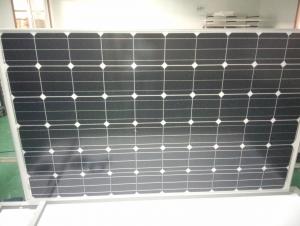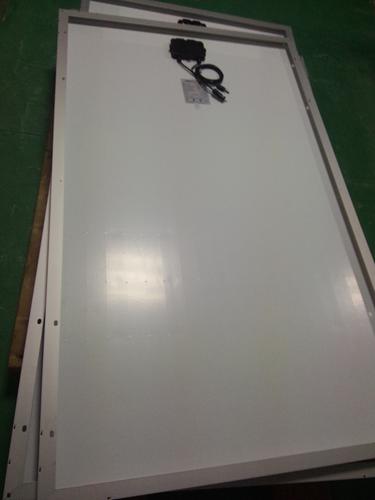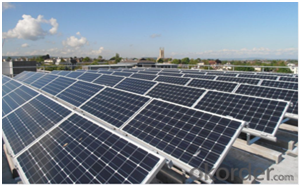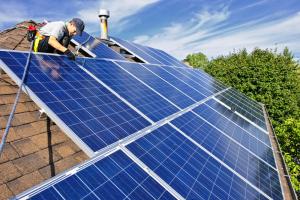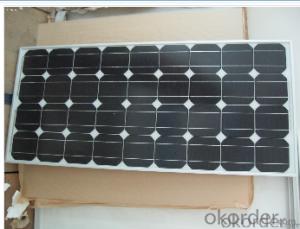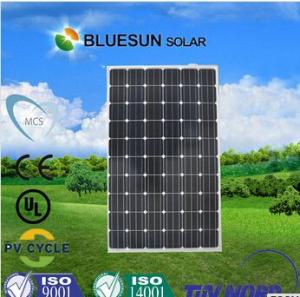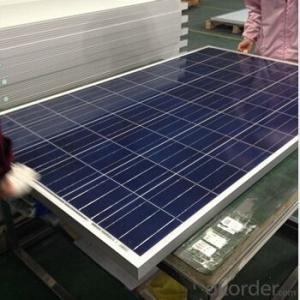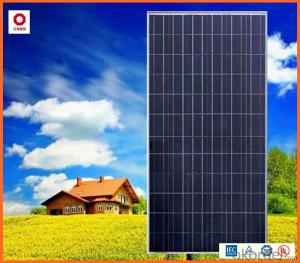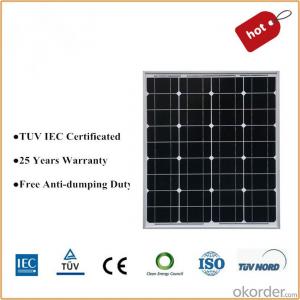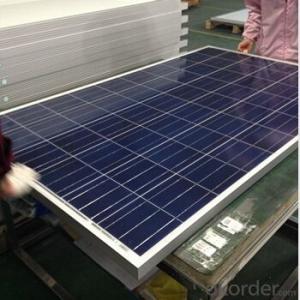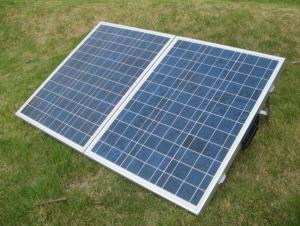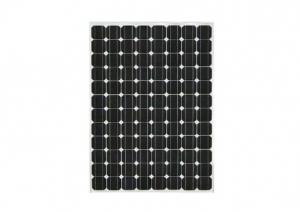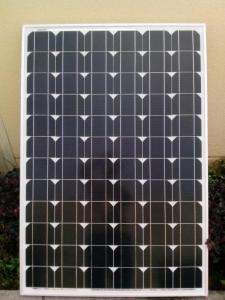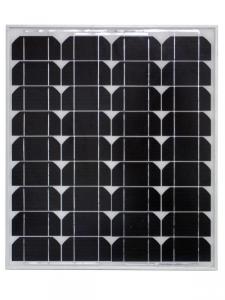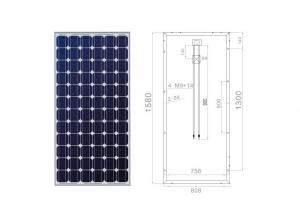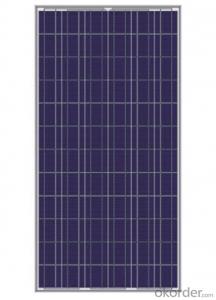FTC Solar Panels (100W Poly) with TUV Certification in China
- Loading Port:
- Shanghai
- Payment Terms:
- TT or LC
- Min Order Qty:
- -
- Supply Capability:
- 3000pcs watt/month
OKorder Service Pledge
OKorder Financial Service
You Might Also Like
Mechanical Characteristics
Max-power Pm(W) 140
Max-power voltage Vmp(V) 17.2
Max-power current Imp(A) 5.82
Open-circuit voltage Voc(V) 21.7
Short-circuit current Isc(A) 6.61
Dimension(mm) 12520*670*30
Weight(kg) 9.5
Operating Conditions
Operating Temperature -40~85°c
Storage Temperature -40~85°c
Maximum system voltage DC 1000V
Temperature and Coefficients
NOCT 48± 2°c
Temperature coefficient of Voc(%/K) -0.34
Temperature coefficient of Isc(%/K) 0.09
Power temperature coefficient(%/K) -0.37
Quality and Safety
1. Rigorous quality control meets the highest international standards.
2. High-transmissivity low-iron tempered glass, strong aluminium frame.
3. Using UV-resistant silicon.
4. IS09001/14001/CE/TUV/UL
Package Picture
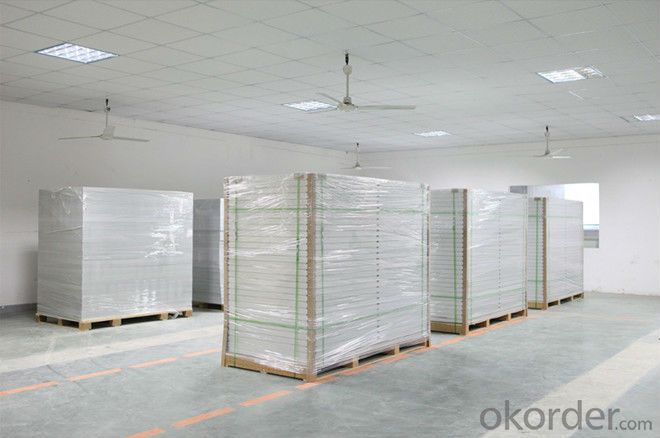

FAQ
I. Will you focus on the safety of the goods during transportation?
Yes, Safety of the cargo is the primary element that we would consider on transportation.
II..How would guarantee the quality will meet the requirements of your clients?
Before shipment, we will have inspection for each batch of goods.
III..What certificates do you have?
IEC,UL,TUV,CSA,etc.
IV..Can you do OEM according to clients’ requirements?
Yes, we have our own brand while we can provide OEM service.
- Q: Can solar panels be installed on a restaurant or food establishment?
- Yes, solar panels can be installed on a restaurant or food establishment. In fact, many restaurants and food establishments have already embraced solar energy as a sustainable and cost-effective solution to power their operations. Installing solar panels can help reduce energy expenses, lower carbon footprint, and showcase the establishment's commitment to environmental responsibility.
- Q: I have a cabin that is way out in the middle of no where, it would cost 000's of dollars to get power to it. If I have a 8,000 BTU air conditioner that runs on 25 volts and 5 amps (or 875 watts)How many solar panels will I need to run this during the day, plus charge the batteries to run it all night? How many batteries would I need
- OK, in addition to the solar panels, you wil need an inverter (DC to AC; 2V t0 20V) capable of delivering 20A continuously and as much as 40A for the compressor starting surge, and a fairly large battery bank capable of delivering something over 2000 watts continuously (losses in the charging and conversion process) as well as the surge. So, if your actual demand is now calculated around 2000 watt/hour, and you need to both run the unit and charge batteries during the daylight hours - and considering that the ideal charging rate for a lead-acid battery is on the order of 0% of its capacity, you will need a huge reserve on the battery section and a huge excess on the solar section to make up for the 5 hours maximum input. So, the average high-quality deep-discharge battery will do about 400Ah @ 2.6V. Which comes to 5040 watts for one hour. For round figures, it will give you 2000 watts for 2.5 hours. You will need a minimum of eight of them just to make your system run for the 9 hours you are anticipating. Given that you do not want to run the batteries to zero each night, a 50% reserve would be a wise investment - comes to now twelve (2) batteries. Now, you will have to make 2000 watts (to run the unit) and also produce and another 8600 (per hour for five hours) watts to charge the batteries for the next night. Again, for round figures, you will need 0,000 watts of solar power, or seventy (70) panels. At ~0 watts/s.f. (00 watts/meter), that comes to about 000 square feet or 00 square meters. Modern non-crystaline panels may reduce this by 20%, or so but no more than that. You will be charging the batteries at roughly 20% of their discharge capacity - which will pretty much cut their service live in half, or so. As the average deep-discharge battery has about an 8-year life span under ideal conditions (and your situation will be far from ideal) you may expect to replace them every four years or so with good care. Much less with no care.
- Q: Can solar panels be installed on a barn or shed?
- Yes, solar panels can be installed on a barn or shed. In fact, barns and sheds are often great locations for installing solar panels as they typically offer ample roof space and are often in areas with good sun exposure. Installing solar panels on a barn or shed can help generate clean, renewable energy and potentially offset electricity costs for the building.
- Q: I am curious about how much of the energy that a solar panel of a given size and capacity will produce in it's lifetime, and what fraction of that energy was required to produce it in the first place?
- The attached link is to an article from the 200 Home Power magazine. In that article the energy payback was found to be between 2 and 4 years. Newer panels are more efficient primarily because the silicon wafers used today are thinner. The silicon cell embodies most of the energy required to make a solar panel. Today most solar panels will produce the amount of energy required to manufacture them in between about 9 months and 2 years depending upon the specific technology used to make it. Solar panels are expected to produce energy for between 30 and 50 years. Therefore it takes around 5% of their total energy production to produce them. Note that these figures depend upon where the panels are installed. Panels in very sunny areas may generate more than 3 times the energy of panels in a cloudier area. Edit - The energy payback meta-study that carbonates references below mention one particular study Alsema (2000), which the authors used as a baseline to come up with their 4 year payback figure. These studies DO NOT assume ideal conditions. The Alsema study assumes an annual an irradiation of 700 kWh/m2/yr. That is the United States average irradiation and does take into account cloudy weather and the like. Under idea conditions the amount of energy collected can be almost twice as much. Albuquerque New Mexico is an example. The figures I mentioned above are recent values reported by several different panel manufacturers with whom I discussed the issue at the 2006 IEEE 4th World Conference on Photovoltaic Energy Conversion held this May. The very long payback times that carbonate highlights are almost certainly wrong. The study he references concludes that paybacks range between 2 and 8 years with 4 years being the most likely. In my opinion payback times are actually a fair bit shorter based on conversations with the manufacturers.
- Q: Can solar panels be used to power air conditioning units?
- Yes, solar panels can be used to power air conditioning units. However, the size and efficiency of the solar panel system required will depend on factors such as the size of the air conditioning unit, climate conditions, and energy consumption. It is important to properly assess the energy needs and consult with professionals to determine the appropriate solar panel system for powering air conditioning units.
- Q: When you consider that solar panels will not produce enough electricity in their service life to cover their cost should we subsidize them anyway? that much of the cost of a solar panel is the energy to manufacture, install, transport and maintain them. Shouldn't the market determine whether they are worth installing?Is subsidizing them taking money away from research that could be spent on more viable alternatives?Should we be taxed to pay for others solar panels when they don't work?
- Yes, okorder /... Bottom line is that government subsidies encourage people to buy solar panels, and make it possible for many who could otherwise not afford it. The more solar panels are purchased, the more the price will go down, and the more quickly the technology will be able to advance.
- Q: how to use a motor with solar panel
- A solar panel cannot operate a motor by itself. A typical system operates like this: The solar panel is connected to a charge controller which is connected to a battery which is connected to a motor controller which is connected to the motor. All these components must be compatible with each other. So,in other words, you can't run just any old motor with a solar panel.You can buy a system like an electric gate opener which is solar powered.
- Q: How much does 000 square feet of solar panels cost? This is for a pool with dimensions 75ft by 25ft? How much will it cost including installation fee and the water heater?
- Are you asking about solar water heaters or solar electric panels?
- Q: Can solar panels be damaged by hail?
- Yes, solar panels can be damaged by hail. Hailstones can cause physical damage to the panels, such as cracks or shattered glass, impairing their ability to generate electricity efficiently.
- Q: How do you know when it is a good deal to buy a solar panel. For example, what is a good cost per watt, how many volts should I expect, etc.
- first okorder / example: house roof is 20' x 20' 20' = 240, so sq. inches of roof is = 57,600 say rain fall for your area is 3 per month on average. 57,600 x 3 = 72,800 of rain collected. Using the conversion chart link above, that many cubic inches of water = 750 gallons of water free per month. Look at your water bill and see how much you use. Solar panels take on average 2-20 yrs to pay themselves off, just in time for them to be replaced. Paddle wheels go on for just about forever. We still find large paddle wheel mills in the USA that are over 200 yrs old, and still functioning.
Send your message to us
FTC Solar Panels (100W Poly) with TUV Certification in China
- Loading Port:
- Shanghai
- Payment Terms:
- TT or LC
- Min Order Qty:
- -
- Supply Capability:
- 3000pcs watt/month
OKorder Service Pledge
OKorder Financial Service
Similar products
Hot products
Hot Searches
Related keywords



